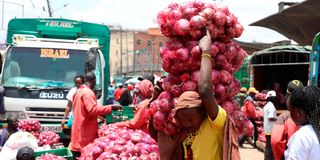The market trends for onions

Onion traders at Muthurwa market, Nairobi County, on October 10, 2022. The cost of producing a kilogramme of onions ranges from Sh6 to Sh12.
Farmer Desmond’s onion production is at bulb formation. This is a critical stage, hence the need to ensure the crop gets adequate water.
Potassium fertiliser has been applied as this encourages bulb formation.
Fertiliser application should stop when onions start pushing the soil away.
At this point, the soil should not be put back around the onions, as the bulbs need to emerge.
However, there should be weeding to ensure the field is free of pests and diseases.
During production, it is important for the farmer to understand the market trend of onions, as this also determines the price.
A majority of farmers in Kenya produce onions between January to March and August to October, depending on region. In other areas, planting coincides with the rainy season.
That means onions are scarce in May as almost all the farmers harvest their produce in February in preparation for the March-April rains.
One of the biggest challenges facing onion farmers is price fluctuation as result of imports.
For farmers who practise irrigation, the trend is different since they can grow onions all year round.
However, the majority of onion farmers in Kenya are smallholder.
This is a challenge to buyers and consumers because they expect to have a steady supply throughout the year.
It makes onion farmers from neighbouring Tanzania have an easy time marketing their produce locally.
In addition, the production cost of onions in Tanzania is relatively low due to the high prices of inputs locally.
Most Kenyan farmers also use hybrid seeds. A kilo of seeds can go for as much as Sh23,000.
Onion prices vary, depending on variety, size and time of selling.
Onions that are well cured fetch high prices since they have a long shelf life.
Prices are also determined by a farmer’s proximity to the market. The cost of transport has gone up due the rising fuel prices.
A kilo at farm gate can go for as low as Sh25 and rise to a high of Sh100 at farm gate price.
At retail level, medium-sized onions cost Sh5 to Sh10 at various markets and outlets.
Prices naturally fall when there is a glut in the market.
The farmer should, therefore, ensure she produces onions all year round, as that means a continued supply to customers.
This calls for proper planning and makes the onion farmer master the production tips.
The cost of production ranges from Sh6 to Sh12 per kilogramme. This, however, varies depending on fertiliser and pesticides used.
During the rainy season, the cost may increase due to the use of pesticides to control fungal diseases.
This is also attributed to the fact that onions grow well in warm climatic conditions.
In our next articl,e we shall look at rust disease in onion production.





